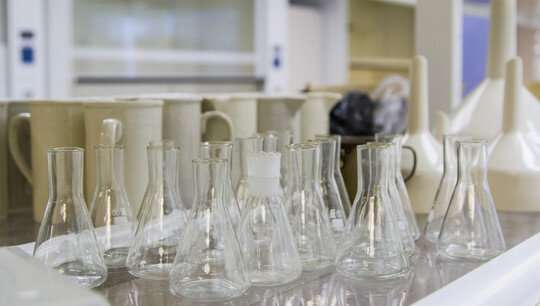New Method for Removing Arsenic from Water

The scientists of Ural Federal University developed a new method of removing arsenic from solutions using aluminum production waste. The authors of the innovative technology described it in the journal "Minerals".
Arsenic is one of the most powerful poisons and carcinogens. It is a by-product of the production of heavy non-ferrous metals, such as copper. It is found in metallurgical waste (slag, dust) and is hazardous for people and the environment. High concentration of arsenic in drinking water causes more than 20% of deaths in southern India and Bangladesh. Thus, the task of finding ways to extract arsenic from water and solutions for its further processing is extremely urgent.
The scientists have suggested red mud as a material for the adsorption of arsenic. It is waste from the bauxite ore processing to produce alumina, raw materials for aluminum production (ferrous oxide makes the mud red). It is commonly known that the components useful for the aluminum industry make up only half of bauxites, and the rest (impurities) go to waste. Therefore, one aluminum plant annually produces more than one million tons of red mud. That being said, its disposal is technologically difficult and economically inefficient due to it being saturated with alkali metals, calcium and sodium, which are involved in the extraction of alumina from bauxite. Therefore, the red mud disposal fields occupy vast territories, posing a potential environmental threat (for example, in 2010 in Hungary, a red mud field breakthrough led to the leakage of over one million tons of red mud, the death of 10 people and pollution of the Danube).
'Solving the problem of increasing the efficiency of bauxite processing, we found that by varying the temperature of the process of treating bauxite with caustic alkali, it is possible to obtain red mud with different physical properties – for example, magnetic. In addition, the specific surface area increases which means the particles become smaller. It was suggested that what we faced was nanodispersed particles of maghemite, a magnetic modification of iron oxide, one of the components of red mud,' Andrei Shoppert, researcher at the Department of Nonferrous Metallurgy of UrFU, says.
In solutions (including water) arsenic is present in the form of anions – negative particles – and the particles of maghemite are positive, so they attract and retain particles of arsenic. Since maghemite has magnetic properties, there is no need to resort to filtering the solution—you can separate the resulting maghemite and arsenic compounds from it using an external source of magnetic field. Thus, the process of arsenic adsorption is simpler and cheaper.
'Maghemite has a so-called "zero charge point",' Andrei Schoppert notes. 'In an acidic medium, when the pH level is below this value, maghemite attracts arsenic. However, if pH is above the zero charge point, that is, in an alkaline medium, maghemite releases arsenic into the solution and regenerates. Due to this feature, arsenic can be first concentrated in the solution, and then converted into an insoluble form for subsequent disposal. Besides that, the regenerated mud is recyclable. And it can be repeated for about ten cycles.'
The UrFU scientists have found that the red mud obtained by fusing bauxite with caustic alkali at 300 and 500 degrees Celsius showed the greatest efficiency in removing arsenic. In these modes, 1 gram of red mud absorbs more than 30 milligrams of arsenic, which is comparable to the effectiveness of purposefully synthesized expensive sorbents. Foreign reviewers assessed the method proposed by our scientists positively.
Provided by Ural Federal University